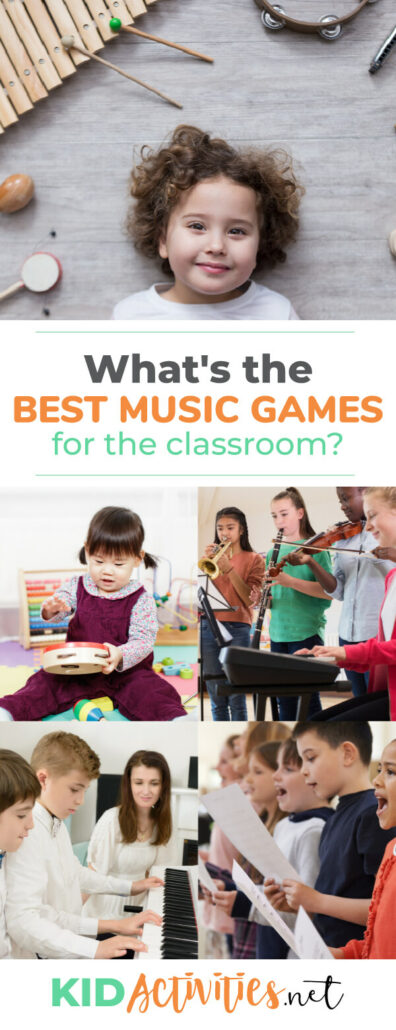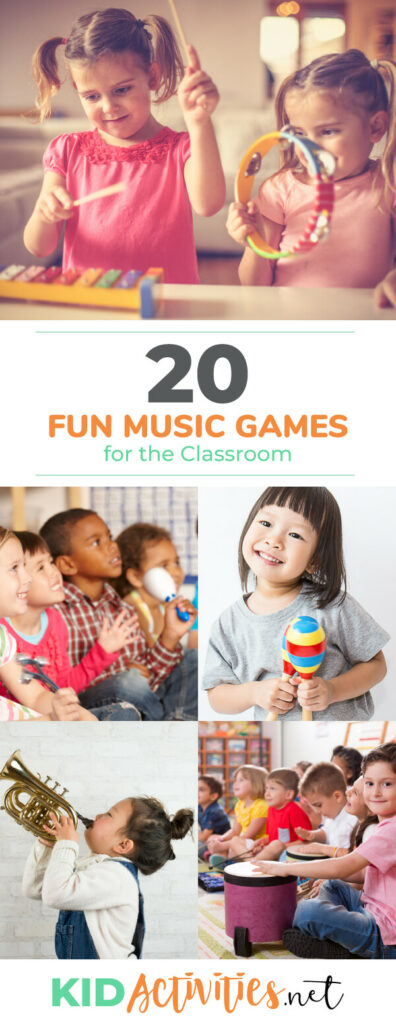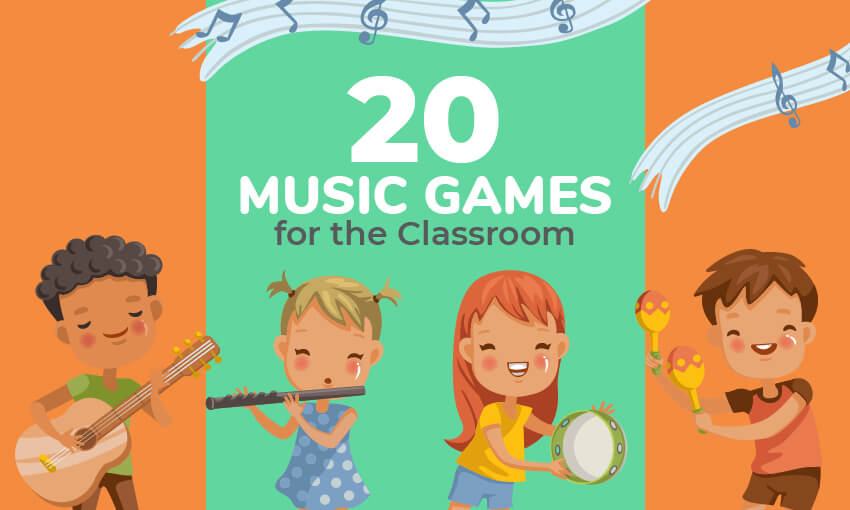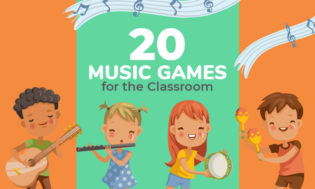Music games are a great way to help kids overcome their shyness and to socialize with other children. They are also a lot of fun, provide children with some exercise, and add some exciting to an otherwise ordinary school day.
If you are looking for music games for the classroom, look no further. This article will share 22 fantastic children’s music games.
This includes some classics like “Pass the parcel” and some fun new games like “Hear it! Clap it! Write it!”.
These musical games are perfect for kids in many age ranges and will deliver many hours of fun.
Why incorporate music games for the classroom?
Music plays a very important role in a child’s development. Researchers have discovered that even unborn can recognize the vibrations of musical sounds.
Infants also have an immediate connection with music as demonstrated by their love of lullabies and eagerness to dance along to music.
As children grow older, they begin to fall in love with the music in children’s programs like Peppa Pig, Teletubbies, Postman Pat, Thomas & Friends, and The Wiggles.
They quickly memorize the melodies and lyrics of the many songs they hear.
Music helps children learn new things. Most children will learn how to count, how to say the alphabet, and how to pronounce certain words with the help of music.
Some of the many advantages of incorporating music into the classroom, include:
Music helps children’s literacy and communication skills
When a child learns a new song and begins to sing it with other children, they will improve their literacy and develop a greater understanding of the meaning of specific words.
Music will also help them improve their communication skills. by helping them to pronounce new words and develop better fluency of speech.
Music games can help a child develop physically
Many music games involve children clapping along or playing percussive musical instruments.
These games will help the children improve their coordination skills and develop a sense of timing.
Their motor skills will improve and they will learn how much fun playing a musical instrument can be.
Music games give children self-confidence and social skills
Children can gain a lot of self confidence by successfully participating in musical games.
They discover that they can sing and become confident about using their voice to communicate with others.
Music games can also enhance the social skills of children and encourage them to participate in group events.
Music improves cognition
Researchers have discovered that listening to music can change how the brain works.
It can dramatically improve concentration, memory, thinking skills, spatial intelligence and other cognitive capabilities.
The best music games for the classroom
Here are some of the best music games for the classroom. We’ll start with a few music games for younger children then move onto music games for teenagers.
#1 – Little Maestros
This fun music game is perfect for classroom environments and is a great way to introduce young children to the idea of reading or writing sheet music.
What you will need
- Sheets of paper
- Pencils or pens
How to play Little Maestros
Start by designating some symbols for the different sounds that the children can make using their bodies.
You could assign different symbols for clapping, whistling, tapping the table, stomping, slapping themselves on the thighs, shouting a word and so on.
The symbols need to be things they can write quickly, like lines, circles, waves, and triangles. Assign at least 4 symbols to different sounds.
Next, demonstrate how to write down a simple rhythm that you have made up.
Once the children understand the concept, write a few more examples on the white board and have the children “read” the musical rhythms. Encourage the children to write their own unique rhythms and have the class perform them.
#2 – Freeze Dance
This is a very fun game that kids love to play. The rules are simple which makes it ideal for young children in kindergarten. It can help improve the children’s cognition, motor skills, and social skills.
What you will need
- Some music to dance to
How to play freeze dance
Tell the children they should dance while the music is playing. However, when the music stops, they have to freeze in their dancing position.
The game works best with uptempo tracks. Tell the kids to look around to check out the funny poses that their classmates are stuck in.
#3 – Hear it! Clap it! Write it!
This is a great game for teaching young children the fundamentals of writing rhythms.
Start by teaching each child how the 4/4 time signature works and explain what whole notes (semibreves), half notes (minims), quarter notes (crotchets), and eight notes (quavers) are.
Give each child a dry erase markers and a plastic covered piece of cardboard with 16 squares (four rows of for). Then, clap out some basic rhythms and have the children clap them as well.
Ask the children to then write the rhythm into the squares. Gradually build up to more advanced rhythms.
Once the children have learned the basics, split them into groups and have them clap different rhythm to each other. Learn more about Hear it! Clap it! Write it!
#4 – Musical clothes
This is another game that is often played at parties by translates to the classroom very well. It is a lot of fun and works well with younger students.
What you will need
- A bag of unusual clothing and accessories (whacky hats, rubber noses, wigs)
- Chairs
- A device to play music on
How to play musical clothes
Start by arranging the chairs in a circle. Turn the music on and have the children hand the bag of crazy items to one another in a clockwise direction.
When you press pause, the child holding the bag must grab an item from the bag and put it on. The child with the whackiest costume when the bag is empty is the winner.
#5 – Animal dancing
This classic game requires children to be creative and helps them socialize with their classmates in a fun way.
How to play animal dancing
Play some music for the children to dance to. Once they get a groove on, shout the name of an animal or point to a picture of an animal.
At this point, the children must start dancing like that animal. They can also make the noises that the animal might make in the wild.
#6 – Pass the parcel
This classic game is often played at parties but can also be used in the classroom as a way to give the children a break from school work.
It can be modified to make it more interesting by having children sing or clap along with the music.
What you will need
- Wrapping paper or newspaper
- Lollies or little toys
How to play pass the parcel
Start by wrapping some lollies or toys in several layers of wrapping paper. Have the children sit in a circle and play some music.
While the music is playing the children will sing along as they continually pass the parcel in a clockwise direction.
When stop the music from playing, the child holding the present gets to unwrap one layer of wrapping paper.
The child who unwraps the last layer gets to eat the treat or keep the toy. If you want to make the game feel more fair, give every child another treat when it is completed.
#7 – Play homemade drums
One of the easiest ways to get young children creating music together is to have them play percussive instruments.
You can make this activity even more fun and interesting by creating homemade drums with the class.
Use items like tin cans, empty yoghurt containers, boxes, and coffee containers. Clean the containers, then tape or glue some construction paper to the top to act as a drum head.
Your homemade drums can also be decorated with stickers, illustrations, or glitter to make them more attractive.
The children are then be placed into groups to form a percussive orchestra. They will be taught different rhythms and the teacher will use hand gestures to tell them when to start or stop playing.
Don’t want to make your own? You can buy one of the best toddler drum sets.
#8 – Musical hot potato
This is a fun musical game for the classroom which acts as a great ice breaker for children who may not know each other particularly well. This fun activity requires a whiteboard.
Start by writing 5 questions on a whiteboard. They should be questions which will help the students learn more about each other like “What is your favorite song?” or “Do you play an instrument?” or “What’s your favorite food?”.
Next, have the children sit in a circle. They will then pass an egg shaker or ball in a clockwise direction while the music is playing.
When you press pause on the music, the child holding the object must answer one of the questions on the white board.
#9 – Name that tune
This is a great game for older children and teenagers who have started to develop a good understanding of contemporary music.
Split the class into 4 or 5 teams. If you would like, let the kids pick their team names. Play 1 to 2 seconds of a song for a team and see if they can guess the song’s title and the artist’s name.
The portion of the song you play can be from the beginning or half way through the song, depending on how difficult you want to make the game.
If the team guesses the song title and the artist’s name, they will receive 3 points. If they don’t know it, you can play another 2 to 3 seconds of the song.
If they get it right on the second attempt, they will earn 2 points. The winner of the game is the first team to reach 30 points.
#10 – Pop Song Charades
Pop Song Charades is a much more interesting version of charades that focusses on music. Split the class into two groups. Have everyone write down three of their favorite pop songs and the name of the artist who sings it on three separate pieces of paper.
Place the pieces of paper into a bowl. Then, one at a time, a member from each team will act out the song and see if their team mates can guess it. The winning team is the one that correctly guesses the most songs.
#11 – Describe what you hear
This activity helps students learn how to analyze the songs that they hear. It requires them to concentrate on a composition and use creative language to describe what is going on within the music.
This task can be used with children of all ages, but tends to be more valuable when working with children who have some knowledge of basic musical concepts like rhythm, timbre, and melody.
Simply play a song to the class and ask them to focus on its composition. As the song plays, allow students to walk up to the white board and write a single word that describes what they are hearing. After a few minutes, you should have a lot of words on the whiteboard.
Now, work with the class to group the words into categories. Find the words that relate to instrumentation, rhythm, time signature, genre, tempo, timbre, and melody.
Discuss each aspect with the students to help them learn more about music appreciation.
#12 – Create a “Stomp” rhythm routine
This is a fantastic activity for primary school children as it helps them to develop a sense of rhythm in a very fun way. Watch some videos of stop with the class.
They are a musical group that uses a combination of everyday items and their own bodies to make percussive sounds.
Split the class into four or five groups and assign each group a particular set of percussive instruments.
Give them 15 minutes to develop their own percussive routines that are inspired by Stomp and have them perform the routine in front of the class.
#13 – Poison rhythm
The game starts with the instructor clapping a four-beat rhythm that is labeled the “poison rhythm”. They will then clap a series of four beat rhythms to the class, which the class must repeat.
When the instructor claps the poison rhythm, the class should remain silent. If anyone in the class accidentally claps the poison rhythm, they are out of the game. This is a simple and fun way to help students recognize different rhythms.
#14 – Compose a rap
Musical composition is a rewarding activity that gives children and teenagers a chance to express themselves.
Rapping is a fantastic form of musical composition for children because they don’t need to be able to read or write music to create an engaging song.
Start by teaching the children some examples of the ABBA and AABB rhyming schemes often used in rap.
You can also share some topics for the children to write about. Have them split up into groups of 3 or 4 and get them to write a short rap. Each student can rap a verse of the song.
They will have a lot of fun while learning a lot about song writing and expressing their own creativity.
#15 – Random rhythms
This simple game helps student learn more about writing and clapping rhythms. Each child is given a six sided dice. The instructor will assign a rhythmic value to each number of the dice.
So, a 1 might be a crotchet, a 2 is a musical rest, a three is a triplet, and so on. The students will then roll their dice and place their random rhythm onto a blank page.
Once they have completed 16 bars of rhythm, they can clap it to the classroom.
#16 – I Have, Who Has
At the start of this game, each student will receive a card that has two rhythms on it — one to identify (“who has”) and one to repeat (“I have”). The students will sit in a circle and clap their “who has” rhythm.
When a child hears the rhythm that they have on the “I have” part of their card, they put their hand up. You can either make your own I Have, Who Has rhythm cards.
#17 – Create a commercial
This is another game that focuses on musical composition. Divide the class into groups of 3 to 4 students. Give each group access to musical instruments like electronic keyboards, guitars, wind instruments, and percussive instruments.
Give them a product that they must write a jingle for. The team with the best jungle wins! Your students will come up very funny lyrics and corny melodies.
#18 – What’s that sound?
This simple game will teach students about the many weird wonderful musical instruments. Start by playing students short clips of various musical instruments.
This should include unusual instruments that the students may not encounter in their daily lives, like the obo, sitar, theremin, hydrolauphone, and djembe.
Then, play some songs and ask the class which instruments they recognize in each track. Add in some world music tracks which feature uncommon instruments.
#19 – Music trivia
Split the class into teams of 3 to 4 students. Ask each team to choose a funny music related name like “E=MC Hammer”, “Quizteama Aguilera”, or “Let’s Get Quizzical”.
Each team gets a triangle or bell. Ask the class a series of music related questions. These could include technical question like “How many semiquavers can fit into a bar of 5/4?” or “What was the name of the Prince’s first album?”.
The first team to ring their triangle and successful answer the question gets a point. The first team to 15 points wins.
#20 – Mood music
This is a great game for getting students to appreciate different kinds of music. It also gives them a chance to express themselves creatively and share a few laughs.
Create a diverse playlist that features songs in many genres. This should include everything from John Coltrane and BB King through to Wagner, and Jon Hopkins.
Have the students stand in a circle. Ask them to close their eyes while you play a segment of each song.
Tell the students to focus on the emotional qualities of the music and encourage them to express that physically by dancing on the spot.
After 30 seconds ask them to open their eyes so they can appreciate each other’s dance moves. Have a quick discussion about the feelings that the song evoked before moving on.
#21 – Limbo – How low can you go
This is a familiar music game for kids that needs no introduction. What you need is just music, a pole, you can use a broom or something like that.
The set up is that all the kids stand in a line in front of the pole, while two people hold it at a certain height above the ground ( start high so it will be easy ).
When the music starts, each kid goes below the pole without any part of his body other than his feet touching the ground.
Sounds easy enough right? Well, every round the pole gets lower and lower, so it will for sure be much more challenging when it gets low enough.
#22 – Spin the microphone
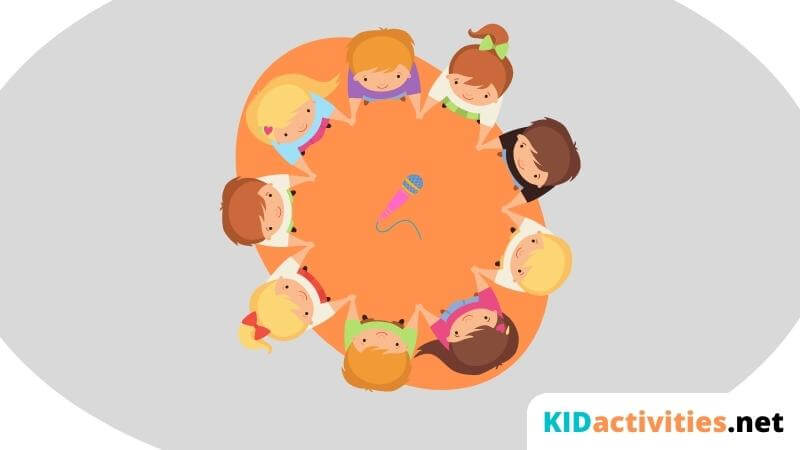
You know the game spin the bottle, which is usually for more mature adults, so this is like that, only in a musical way and more fun.
The kids sit in a circle, take a toy microphone and spin it in the center of the circle, the kid that the mic is pointing at needs to take it and start sinning a song.
If someone is shy, don’t put them on the spot, and instead just ask them to name their favorite song and pass it on.
I hope you enjoyed reading Music Games for the Classroom. For more fun classroom games, subscribe to the site or follow us on social media.
